Chemically Modified Silicone Oil with Enhanced Tribological and Anti-Foaming Properties
Abstract
:1. Introduction
2. Experimental
2.1. Materials
2.2. Synthesis of the Chemically Modified Silicone Oil
2.3. Characterization and Measurements
2.3.1. FTIR Analysis
2.3.2. Tribological Tests
2.3.3. Surface Analysis
2.3.4. Anti-Foaming Performance
3. Results and Discussion
3.1. Characterization of Chemically Modified Silicone Oil
3.2. Dispersion Stability Test
3.3. Tribological Properties
3.4. Worn Surface Analysis
3.5. Anti-Foaming Performance
4. Conclusions
Author Contributions
Funding
Conflicts of Interest
References
- Aziz, T.; Fan, H.; Khan, F.U.; Haroon, M.; Cheng, L. Modified silicone oil types, mechanical properties and applications. Polym. Bull. 2019, 76, 2129–2145. [Google Scholar] [CrossRef]
- Partenhauser, A.; Laffleur, F.; Rohrer, J.; Bernkop-Schnürch, A. Thiolated silicone oil: Synthesis, gelling and mucoadhesive properties. Acta Biomater. 2015, 16, 169–177. [Google Scholar] [CrossRef] [Green Version]
- Hu, Z.; Liao, M.; Chen, Y.; Cai, Y.; Meng, L.; Liu, Y.; Lv, N.; Liu, Z.; Yuan, W. A novel preparation method for silicone oil nanoemulsions and its application for coating hair with silicone. Int. J. Nanomed. 2012, 7, 5719–5724. [Google Scholar]
- Jiang, X.; Hu, H.; Bai, Y.; Tian, X.; Huang, D.; Wang, S. Synthesis and properties of the vinyl silicone oil modified polyacrylate core-shell latex as a binder for pigment printing. J. Adhes. Sci. Technol. 2013, 27, 154–164. [Google Scholar] [CrossRef]
- Dresp, J.H.; Menz, D.H. The phenomenon of “sticky” silicone oil. Graefe’s Arch. Clin. Exp. Ophthalmol. 2007, 245, 863–868. [Google Scholar] [CrossRef] [PubMed]
- Wang, C.; Sun, C.; Ding, F.; Yi, Y. Study on the synthesis of fluoroalkyl and polyether co-modified polysiloxane and appraisal of its foam-breaking and -inhibiting performance. J. Chin. Chem. Soc. 2017, 64, 674–682. [Google Scholar] [CrossRef]
- Haut, J.; Larricart, J.P.; van Effenterre, G.; Pinon-Pignero, F.L. Some of the most important properties of silicone oil to explain its action. Ophthalmologica 1985, 191, 150–153. [Google Scholar] [CrossRef] [PubMed]
- Aslfattahi, N.; Samylingam, L.; Abdelrazik, A.S.; Arifutzzaman, A.; Saidur, R.J.S.E.M. Mxene based new class of silicone oil nanofluids for the performance improvement of concentrated photovoltaic thermal collector. Sol. Energy Mater. Sol. Cells 2020, 211, 110526. [Google Scholar] [CrossRef]
- Liu, Z.; Liu, H.S.; Guan, R.F.; Zhou, C.J. Preparation and characterization of hyperbranched silicone oil by hydrosilylation reaction. Appl. Mech. Mater. 2013, 395–396, 363–366. [Google Scholar]
- Sun, N.; Xiao, Z. Improvement of the thermostability of silicone oil/polystyrene microcapsules by embedding TiO2/Si3N4 nanocomposites as outer shell. J. Mater. Sci. 2017, 52, 10800–10813. [Google Scholar] [CrossRef]
- Lonsky, P. Some characteristics of silicones developed as lubricants. J. Synchrotron Radiat. 1985, 1, 302–313. [Google Scholar] [CrossRef]
- Miller, A.A. Radiation stabilities of arylmethylsiloxanes. IEC Prod. Res. Dev. 1964, 3, 252–256. [Google Scholar] [CrossRef]
- Barca, F.; Caporossi, T.; Rizzo, S. Silicone oil: Different physical proprieties and clinical applications. BioMed Res. Int. 2014, 2014, 502143. [Google Scholar] [CrossRef] [PubMed] [Green Version]
- Partenhauser, A.; Netsomboon, K.; Leonaviciute, G.; Bernkop-Schnürch, A. Evaluation of thiolated silicone oil as advanced mucoadhesive antifoaming agent. Drug Deliv. 2016, 23, 2711–2719. [Google Scholar] [CrossRef] [PubMed]
- Han, S.S.; Xu, J.Y.; Zheng, G.; Sun, Y. A dissertation on polysiloxane-antifoaming-agents: Antifoaming principles, synthesis and compound. Adv. Mater. Res. 2011, 301–303, 26–30. [Google Scholar]
- Németh, Z.; Rácz, G.; Koczo, K. Foam control by silicone polyethers—Mechanisms of “cloud point antifoaming”. J. Colloid Interface Sci. 1998, 207, 386–394. [Google Scholar] [CrossRef]
- Yoo, S.S.; Kim, D.E. Minimum lubrication technique using silicone oil for friction reduction of stainless steel. Int. J. Precis. Eng. Manuf. 2013, 14, 875–880. [Google Scholar] [CrossRef]
- Gu, G.; Wu, Z.; Zhang, Z.; Qing, F. Tribological properties of fluorine-containing additives of silicone oil. Tribol. Int. 2009, 42, 397–402. [Google Scholar] [CrossRef]
- Weng, L.; Wang, H.; Feng, D.; Liu, W.; Xue, Q. Tribological behavior of the synthetic chlorine-and fluorine-containing silicon oil as aerospace lubricant. Ind. Lubr. Tribol. 2008, 60, 216–221. [Google Scholar] [CrossRef]
- Gainer, G.C. Silicone oils for lubricating steel versus steel. Ind. Eng. Chem. 1954, 46, 2355–2362. [Google Scholar] [CrossRef]
- Tabor, D.; Willis, R.F. Thin film lubrication with substituted silicones-role of physical and chemical factors. Wear 1968, 11, 145–162. [Google Scholar] [CrossRef]
- Mannheimer, R. Factors that influence the coalescence of bubbles in oils that contain silicone antifoamants. Chem. Eng. Commun. 1992, 113, 183–196. [Google Scholar] [CrossRef]
- Chen, J.; Huang, X.; He, L.; Luo, X. Foaming of oils: Effect of poly(dimethylsiloxanes) and silica nanoparticles. ACS OMEGA 2019, 4, 6502–6510. [Google Scholar] [CrossRef] [PubMed]
- Ewers, W.; Sutherland, K. The role of surface transport in the stability and breakdown of foams. Aust. J. Chem. 1952, 5, 697–710. [Google Scholar] [CrossRef]
- Kekevi, B.; Berber, H.; Yıldırım, H. Synthesis and characterization of silicone-based surfactants as anti-foaming agents. J. Surfactants Deterg. 2012, 15, 73–81. [Google Scholar] [CrossRef]
- Rutnakornpituk, M.; Ngamdee, P. Surface and mechanical properties of microporous membranes of poly(ethylene glycol)–polydimethylsiloxane copolymer/chitosan. Polymer 2006, 47, 7909–7917. [Google Scholar] [CrossRef]
- Fraga, A.K.; Santos, R.F.; Mansur, C.R.E. Evaluation of the efficiency of silicone polyether additives as antifoams in crude oil. J. Appl. Polym. Sci. 2012, 124, 4149–4156. [Google Scholar] [CrossRef]
- Owen, M.J.; Groh, J.L. Fluorosilicone antifoams. J. Appl. Polym. Sci. 1990, 40, 789–797. [Google Scholar] [CrossRef]
- Wu, F.; Cai, C.; Wang, L.; Cao, Z.P.; Yi, W.B. Breaking and inhibiting foam performance of modified silicone oils in oil-based systems. J. Dispers. Sci. Technol. 2008, 29, 792–795. [Google Scholar] [CrossRef]
- Xiu, N.I.; Mei, Y.G.; Li, C.S.; Cheng, Y. Synthesis and compounding of polyether modified polysiloxane crude oil defoamer. Oilfield Chem. 2009, 26, 153–157. [Google Scholar]
- Hassan, A.; Jumbri, K.; Ramli, A.; Borhan, N. Physio-chemical analysis of amide and amine poly(dimethylsiloxane)-modified defoamer for efficient oil-water separation. ACS OMEGA 2021, 6, 14806–14818. [Google Scholar] [CrossRef] [PubMed]
- Xu, W.; Zhuang, G.; Chen, Z.; Wei, J. Experimental study on the micromorphology and strength formation mechanism of epoxy asphalt during the curing reaction. Appl. Sci. 2020, 10, 2610. [Google Scholar] [CrossRef] [Green Version]
- Wang, T.; Ye, H.; Zhang, X.; Cheng, J. Uv-curable epoxy silicone with a high refractive index and self-photosensitizing effect. Ind. Eng. Chem. Res. 2012, 51, 15832–15838. [Google Scholar] [CrossRef]
- Pelton, R. A review of antifoam mechanisms in fermentation. J. Ind. Microbiol. Biotechnol. 2002, 29, 149–154. [Google Scholar] [CrossRef]
- Pelton, R. A model of foam growth in the presence of antifoam emulsion. Chem. Eng. Sci. 1996, 51, 4437–4442. [Google Scholar] [CrossRef]
- Said, Z.; Sundar, L.S.; Tiwari, A.K.; Ali, H.M.; Sheikholeslami, M.; Bellos, E.; Babar, H. Recent advances on the fundamental physical phenomena behind stability, dynamic motion, thermophysical properties, heat transport, applications, and challenges of nanofluids. Phys. Rep. 2022, 946, 1–94. [Google Scholar] [CrossRef]
- Yu, F.; Chen, Y.; Liang, X.; Xu, J.; Lee, C.; Liang, Q.; Tao, P.; Deng, T. Dispersion stability of thermal nanofluids. Prog. Nat. Sci. Mater. Int. 2017, 27, 531–542. [Google Scholar] [CrossRef]
- Bakthavatchalam, B.; Habib, K.; Wilfred, C.D.; Saidur, R.; Saha, B.B. Comparative evaluation on the thermal properties and stability of mwcnt nanofluid with conventional surfactants and ionic liquid. J. Therm. Anal. Calorim. 2022, 147, 393–408. [Google Scholar] [CrossRef]
- Chakraborty, S.; Panigrahi, P.K. Stability of nanofluid: A review. Appl. Therm. Eng. 2020, 174, 115259. [Google Scholar] [CrossRef]
- Denkov, N.D. Mechanisms of foam destruction by oil-based antifoams. LANGMUIR 2004, 20, 9463–9505. [Google Scholar] [CrossRef]
- Aveyard, R.; Cooper, P.; Fletcher, P.D.I.; Rutherford, C.E. Foam breakdown by hydrophobic particles and nonpolar oil. LANGMUIR 1993, 9, 604–613. [Google Scholar] [CrossRef]
- Frye, G.C.; Berg, J.C. Mechanisms for the synergistic antifoam action by hydrophobic solid particles in insoluble liquids. J. Colloid Interface Sci. 1989, 130, 54–59. [Google Scholar] [CrossRef]
- Jha, B.K.; Christiano, S.P.; Shah, D.O. Silicone antifoam performance: Correlation with spreading and surfactant monolayer packing. LANGMUIR 2000, 16, 9947–9954. [Google Scholar] [CrossRef]

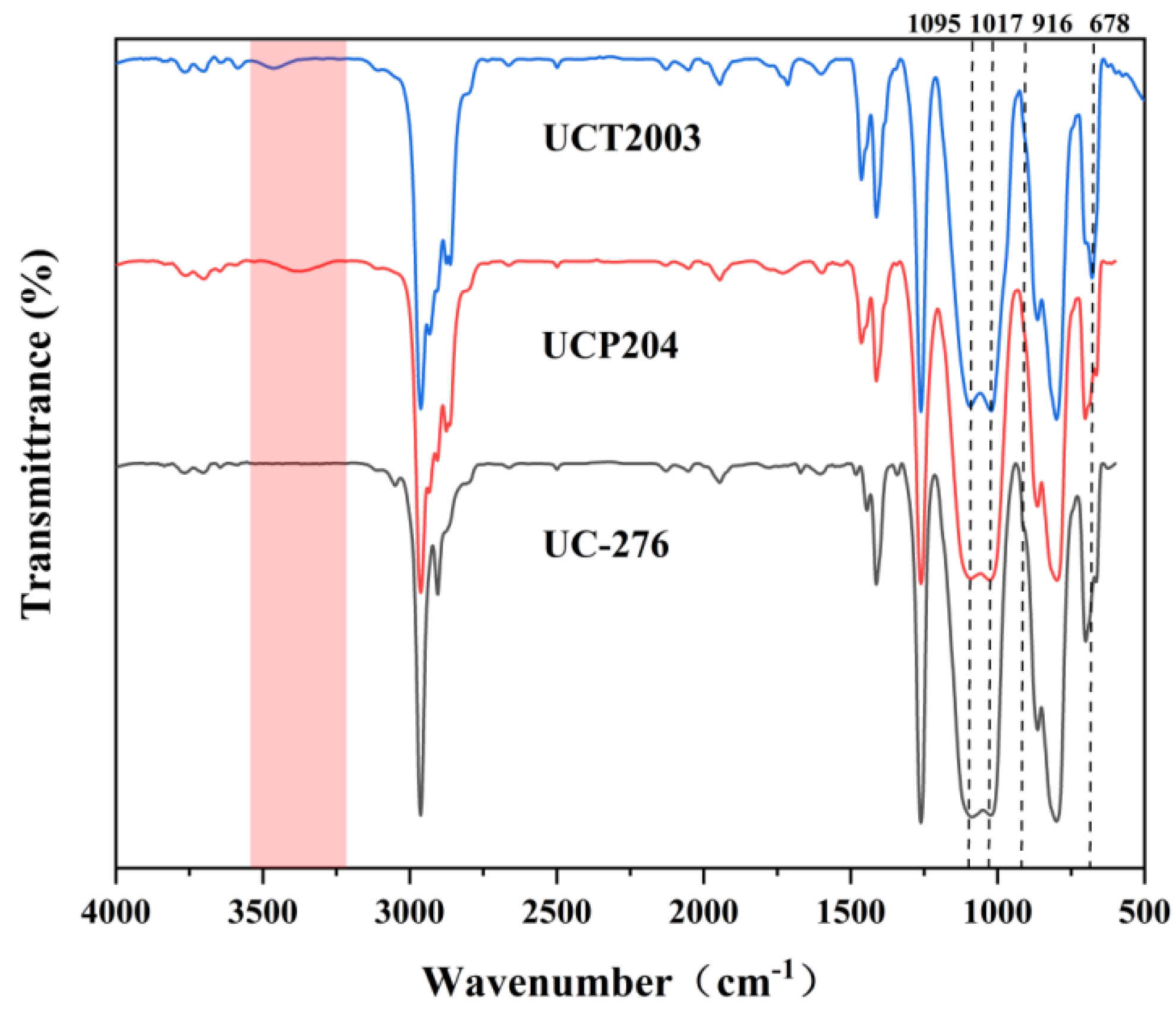
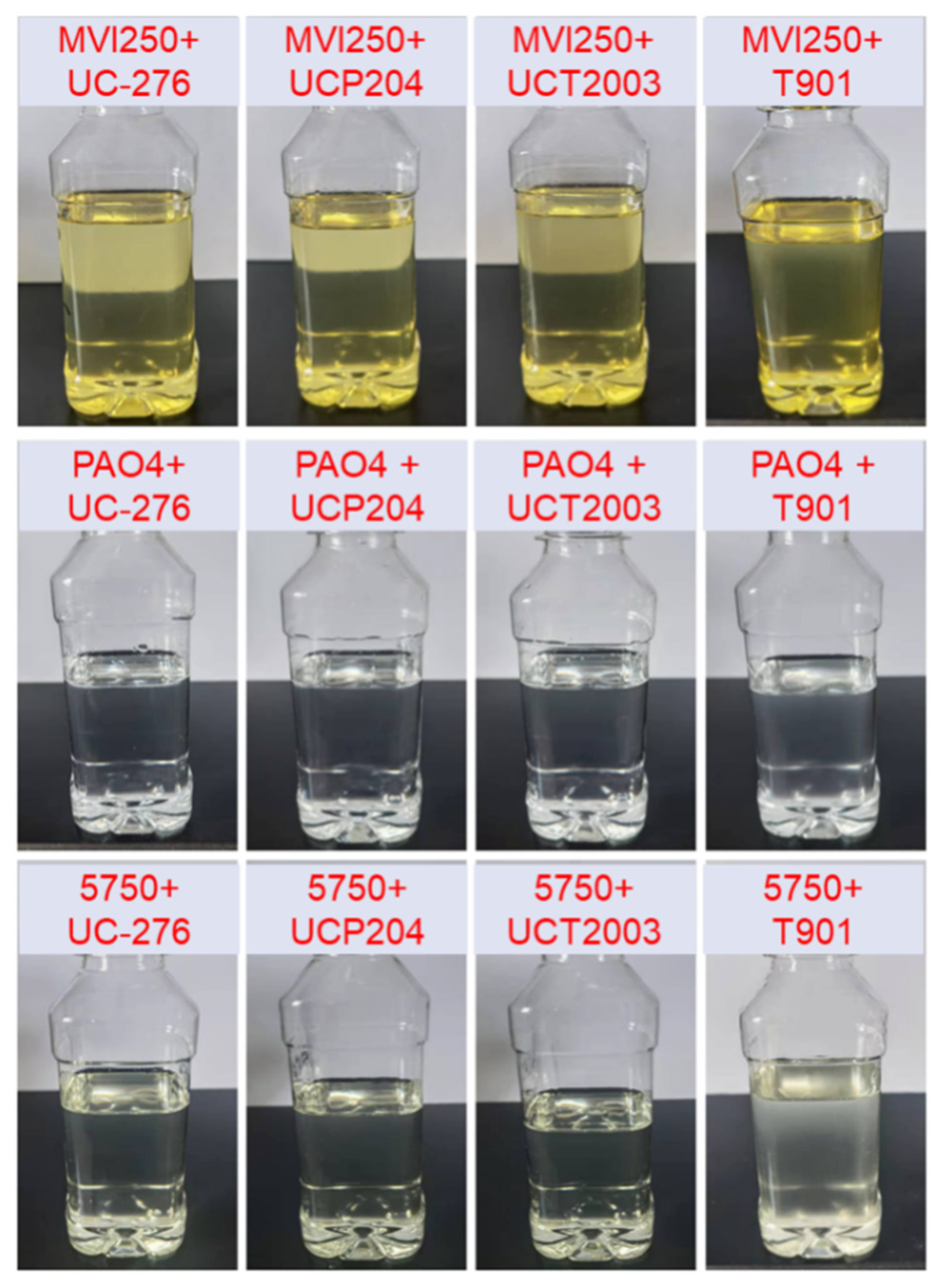
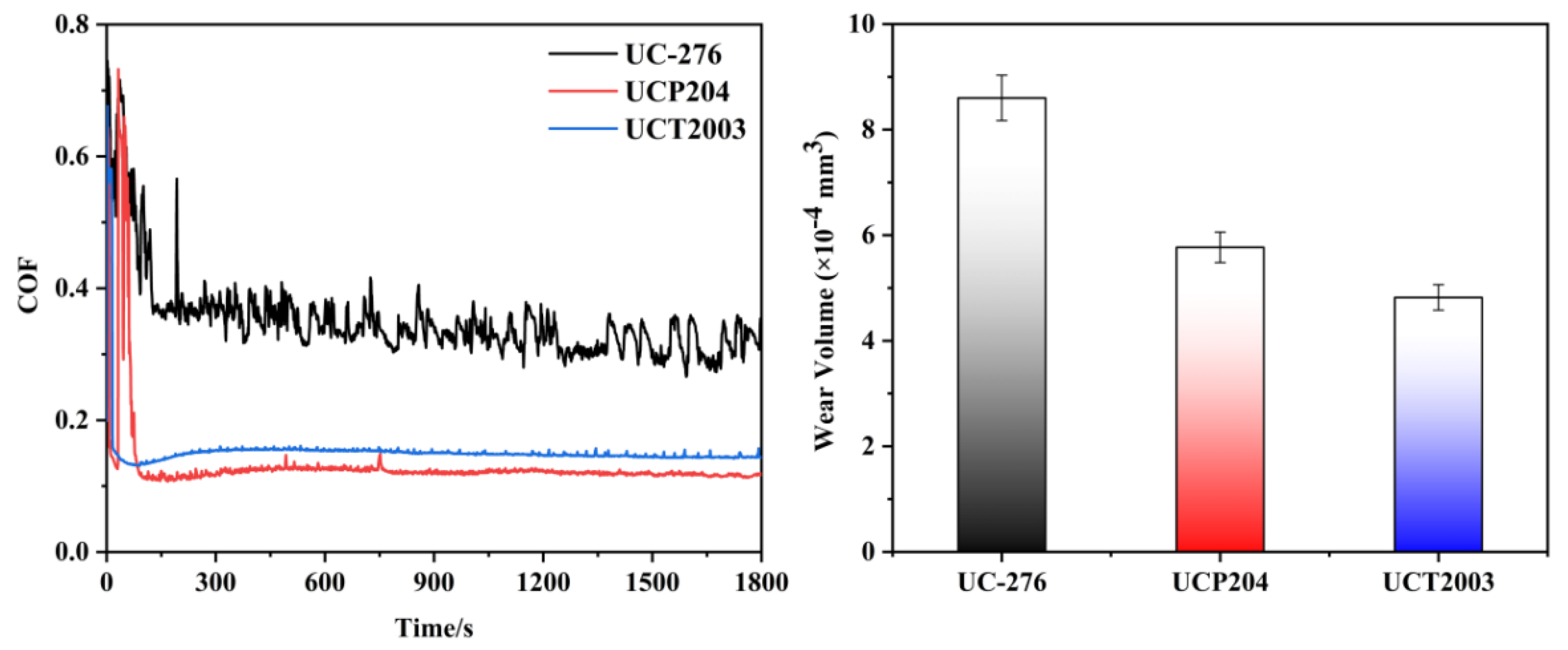

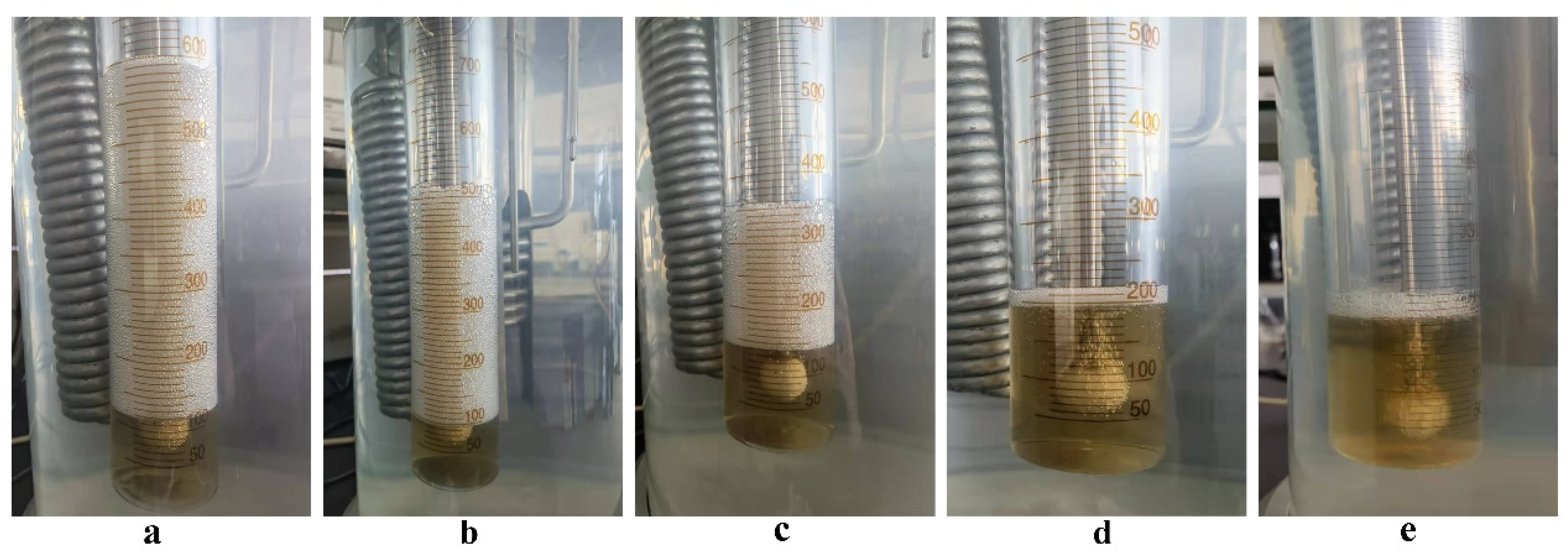

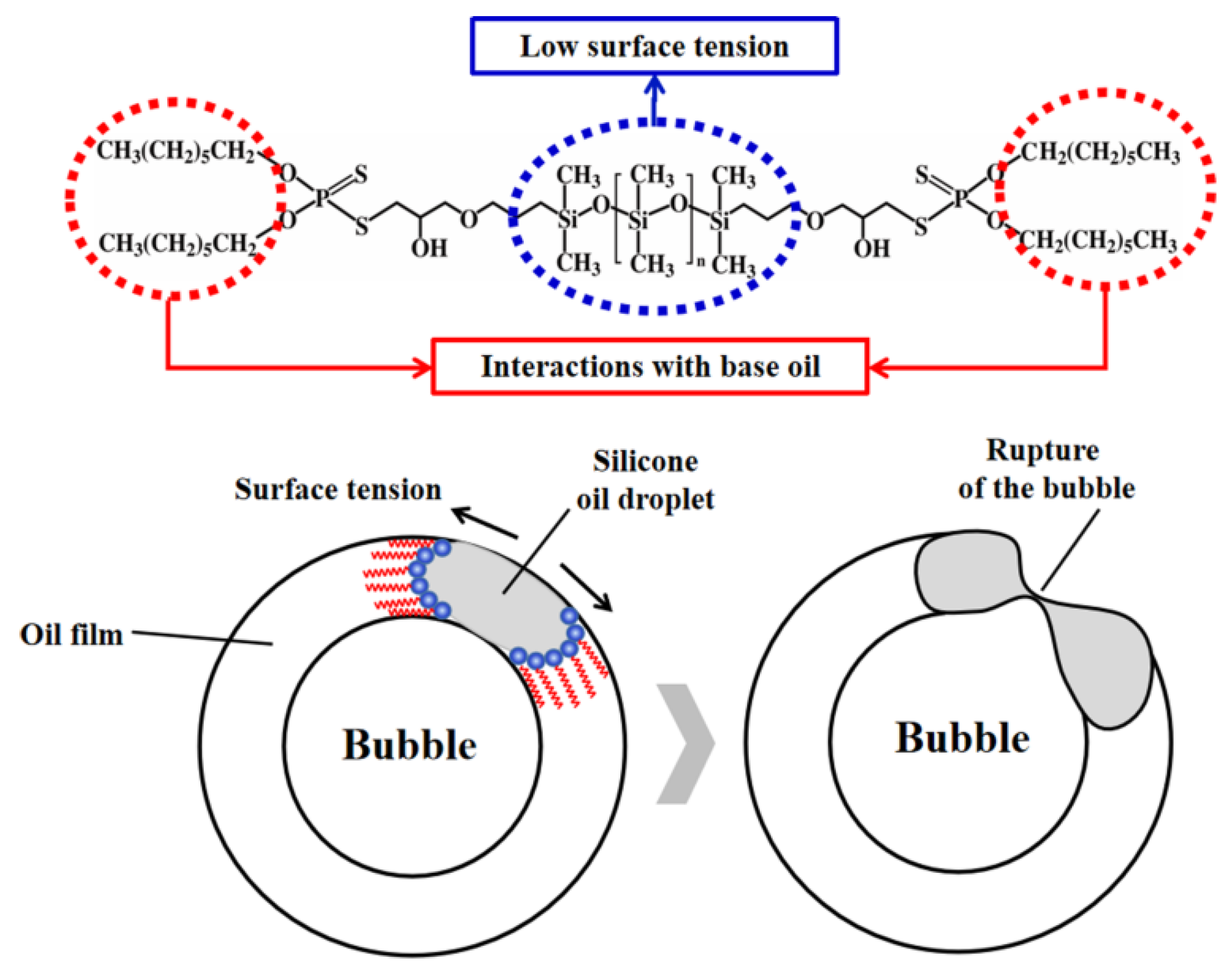
Publisher’s Note: MDPI stays neutral with regard to jurisdictional claims in published maps and institutional affiliations. |
© 2022 by the authors. Licensee MDPI, Basel, Switzerland. This article is an open access article distributed under the terms and conditions of the Creative Commons Attribution (CC BY) license (https://creativecommons.org/licenses/by/4.0/).
Share and Cite
Luan, X.; Zhang, E.; Chen, Y.; Ma, R.; Gong, K.; Li, W.; Wang, X. Chemically Modified Silicone Oil with Enhanced Tribological and Anti-Foaming Properties. Lubricants 2022, 10, 364. https://doi.org/10.3390/lubricants10120364
Luan X, Zhang E, Chen Y, Ma R, Gong K, Li W, Wang X. Chemically Modified Silicone Oil with Enhanced Tribological and Anti-Foaming Properties. Lubricants. 2022; 10(12):364. https://doi.org/10.3390/lubricants10120364
Chicago/Turabian StyleLuan, Xiaosheng, Enhui Zhang, Yunlong Chen, Rui Ma, Kuiliang Gong, Weimin Li, and Xiaobo Wang. 2022. "Chemically Modified Silicone Oil with Enhanced Tribological and Anti-Foaming Properties" Lubricants 10, no. 12: 364. https://doi.org/10.3390/lubricants10120364
APA StyleLuan, X., Zhang, E., Chen, Y., Ma, R., Gong, K., Li, W., & Wang, X. (2022). Chemically Modified Silicone Oil with Enhanced Tribological and Anti-Foaming Properties. Lubricants, 10(12), 364. https://doi.org/10.3390/lubricants10120364




